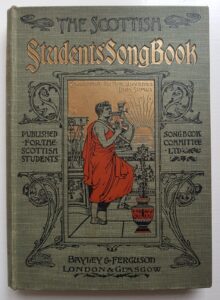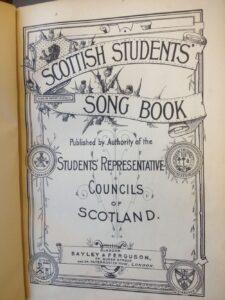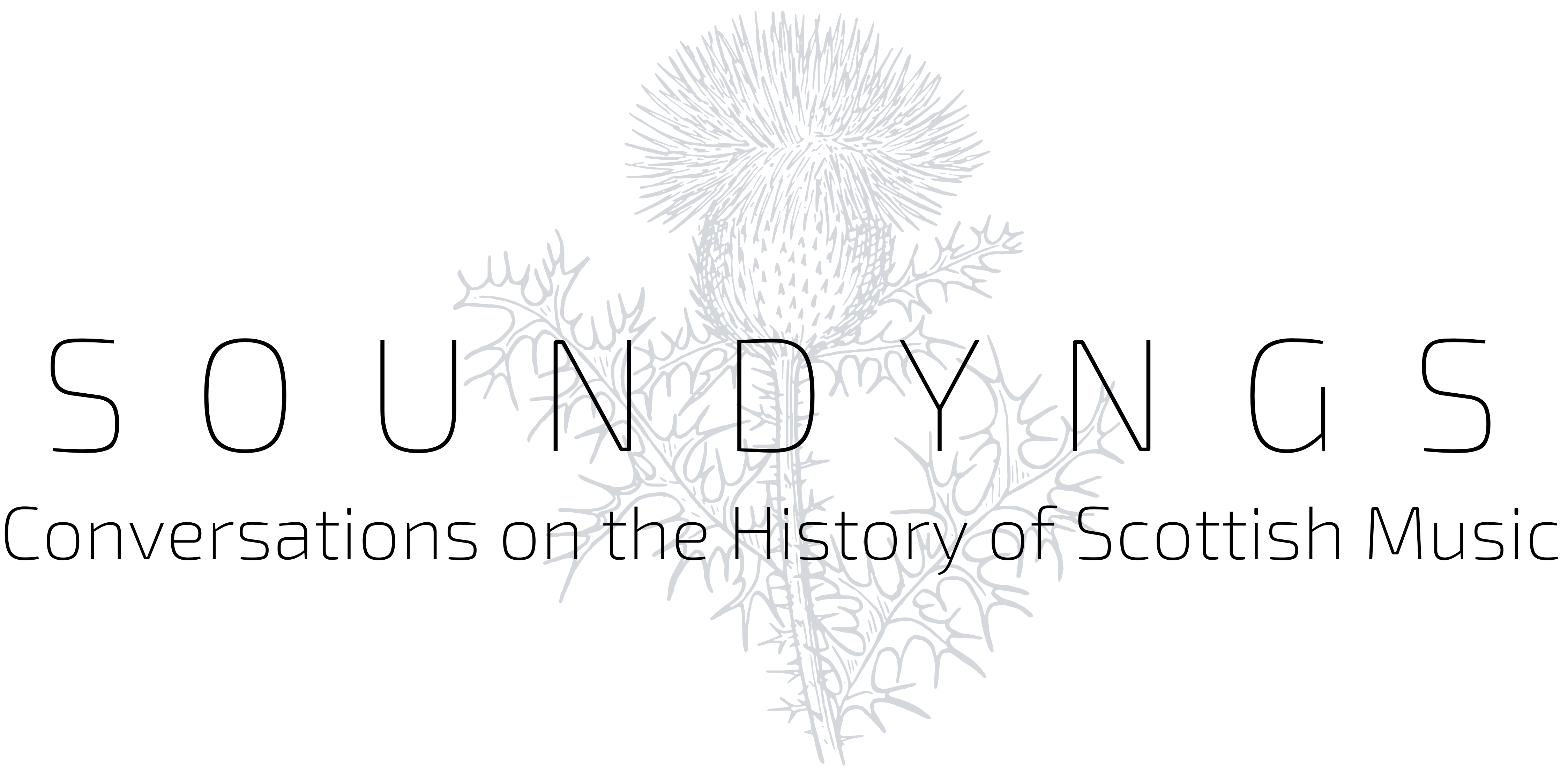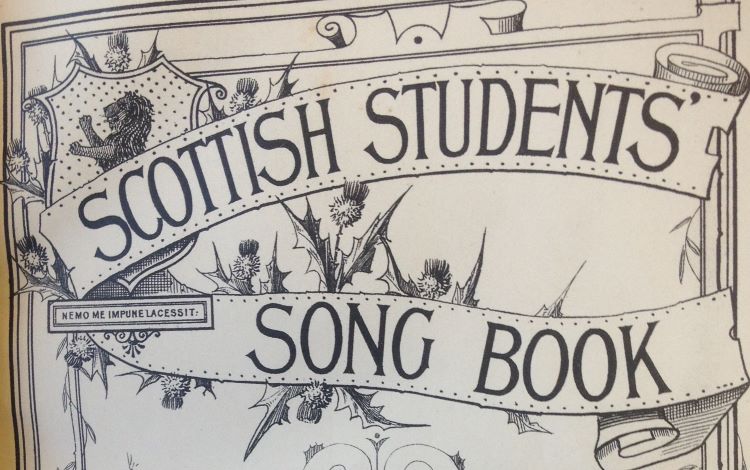Editor: as nights draw in and we begin to spend more time indoors, Rosa Michaelson invites us to think about how students enjoyed themselves around the fireplaces of halls of residence (and possibly pubs) 130 years ago. This week is Hallowe’en , but with the exception of that gory old Scots Ballad ‘The Three Crows’, the 3rd edition (1892) of “The Scottish Students’ Song Book” on my shelf doesn’t really have ghost stories. Rather more, songs to encourage youth to go forth and build empires, and celebrate nationalism at home. I wonder how the anthology reacted to WW1? Rosa talks below about the social ‘purposes’ of this kind of singing … I find myself wondering whether preparing youth for empire-building wasn’t also at that point a conscious aim of many of lyrics sung in many of the songs in these volumes …. Maybe a story for another article….
Imagine yourself in a St Andrews University residence common room one evening during Martinmas term in 1891. First of all, you will have to imagine that you are male, and secondly that you would like to sing some songs. What songs will you choose and how can you be sure that you can remember the words, or that you and your companions sing the same version of a song to the same tune?

Luckily the St Andrews Student Representatives Council has distributed to each residence a number of copies of the brand-new Scottish Students’ Song Book, which they have endorsed, and had a hand in producing via the Scottish Student Representative Councils sub-committee. This new song-book has been strongly supported by one of Scotland’s favourite professors of Greek, Professor Blackie of Edinburgh University, who wrote the introduction, as well as some of the songs, and whose nephew is one the four original editors of this and subsequent editions. Alternatively, each of you may have spent 2/6 on your own copy – given that the first edition sold out after a few weeks, and a second edition was published in July, it is highly likely that some of you have done so (sales of over 3,500 were reported in ‘University’ Jottings, Glasgow Evening Post, 3 February 1892). This means you can pick one of nearly 170 songs to sing together.
So, will you choose one of the local St Andrean university songs, some in Latin, from the University section, or something from the miscellaneous section? The latter makes up the majority of songs in this first edition and includes patriotic and national songs, drinking songs translated from German, songs by other students from American universities, 25 songs from the University of Toronto Song Book (published in 1887), “plantation songs” (from the African-American tradition), and several Scottish songs including some by Burns. There are also several satirical songs for medical students and those struggling with mathematics, and popular numbers by Stephan Foster and from the music-hall repertoire. A “good evening’s singing” is bound to occur whatever you chose. (Editor: look at the national emblems – Scottish lion and thistles – on the front page below):

The Scottish Students’ Song Book (SSSB) was conceived by undergraduates in St Andrews in the late 1880s, and subsequently realised by a group of four editors selected from the main Scottish Universities: Aberdeen, Edinburgh, Glasgow and St Andrews. The convenor was Millar Patrick (St Andrews) who was born in Ladybank, Fife, in 1868 and died in Colinton, Edinburgh, in 1951. He trained for the ministry in Edinburgh (1890-1893) and went on to write Four Centuries of Scottish Psalmody (1949) and The Story of the Church’s Song (1927).
The song book was published by Bayley & Fergusson,Glasgow music publishers, with the first edition launched in March 1891. The introduction was written by John Stuart Blackie (1809-1895), Professor of Greek at the University of Edinburgh. Blackie was one of one of the best-known Scotsmen of his time. He was born in Glasgow His first degree from Marischal College, Aberdeen was followed by three ‘Wanderjahre’ spent at the Universities of Göttingen and Berlin and in Rome. These gave him a life-long love, first of the German language, German student life, songs and culture, and secondly of the Greek language and antiquity. The first were later to inform several of his own books, in particular a collection of songs for students called Musa Burschicosa (1869). This was followed by War songs of the Germans (1870) and Scottish Song(1889).
The early success of The Scottish Students’ Song Book prompted the formation of The Scottish Students’ Song Book Committee, Ltd., an organisation which managed further editions and finances, as trustees on behalf of the Students’ Representative Councils of the Scottish Universities and all Scottish students. Further editions followed, with over 400,000 copies sold according to the archives of the company (‘Records of the Scottish Students’ Song Book Company, Ltd.’, University of Edinburgh Library) The sixth edition of 1897 contains several pages of notes on contributors, including, Sir Arthur Quillar Couch, Charles Villers Stanford and Gerard F. Cobb. This last set Kipling’s Barrack Room Ballads to music and contributed two new settings for the song book.
Editions from the late 19th and early 20th century are easy to find online. In addition to the album-format copies, there were pocket-book versions, some in sol-fa notation (6th edition, 1897, p.366).
In 1912 the committee published The British Students’ Songbook which was revised and enlarged in 1927. This was advertised as containing “200 numbers drawn from entirely fresh sources” (see Further Reading, SSSB1, advert on back of book). In 1937, Student Songs for Camp and College was issued with “100 songs, words and melodies, convenient for the pocket or knapsack” for only a shilling (see Further Reading, SSSB2, advert opposite title page).
Although popular in St Andrews (the University library lists many copies!) the Scottish Students’ Song Book contained a range of songs which reflected a popular repertoire for students in general as well as those important to each institution. In some cases, the books boosted the popularity of a particular song: many of the songs in the first editions were destined to become ‘folk’ songs in the early twentieth century. However, it is notable that the specifically Scottish contribution is relatively small and that there are some omissions of music that we know from other sources to have been popular at the time. For example, there are no Gilbert and Sullivan songs in the song book, although it is evident that some were meant to be included as the University of Edinburgh archive contains eight engraved steel plates for printing sheets of music, each one paginated and marked ‘Cancelled’, of passages of songs from Gilbert & Sullivan operas, including Iolanthe, The Pirates of Penzance and Princess Ida (‘Records of the Scottish Students’ Song Book Committee Ltd.’, University of Edinburgh Library). Whether these omissions were on grounds of committee preference or because of commercial rights issues is not clear from my research to date.
Here are notes on a few interesting songs which remained popular well into the 20th century:
- ‘The Mermaid’ (Child 289): Child dated an early version of this ballad to 1765, but it is probably based on older songs as noted by Stephan Winick (see Further Reading). It was collected in various versions throughout America in the 20th century. A popular version was arranged by Ralph Vaughan Williams; a ‘folk’ version was sung by the Clancy Brothers for over 30 years. The origins of The Mermaid can be found in the mid-17th century song called The praise of Saylors here set forth, a broadsheet ballad found in Glasgow University archives (Winick, 2018; Euing 267, 1658-1664).
- ‘Riding down from Bangor’. A mildly risqué song, written around 1871 by L. S. Osbourne while he was a student at Harvard, and made popular in 1934 in a recording by Frank Crumit. In 1949 George Orwell wrote about the song in an essay of the same name which discusses American children’s literature and American society:
“Somewhat later my picture of nineteenth-century America was given greater precision by a song which
is still fairly well known and which can be found (I think) in the SCOTTISH STUDENTS’ SONG BOOK.
As usual in these bookless days I cannot get hold of a copy, and I must quote fragments from memory.”
(Orwell, 1946)
- ‘The Lady Doctor’: The first two editions (1891) contain a song entitled ‘the Lady Doctor’ which illustrates the problems women faced in obtaining professional status and social acceptance. The (male) singer is at first unhappy to be examined by a lady doctor but by the end of the song is convinced that she is a professional medic. (Editor: St Andrews matriculated its first female graduate, Dr Agnes Blackadder, a doctor of medicine, in 1895).
- ‘Abdul Abulbul Amir’ – This well-known music hall song was written by Percy French for a ‘smoking concert’ at Trinity College, Dublin, during the Franco-Russian war of 1877. French sold the copyright to a London publisher and the song book gives the author as ‘Ali Baba’. The first recording was released by Frank Crumit in 1927. It is good to be reminded that popular song has often reinforced what we can now recognise as deeply problematic racial prejudices; singing together, in the Scottish as well as the German collegiate tradition, can be used to negative as well as positive ends.
Students have always met to sing in colleges and universities, in European and European-influenced education systems. For example, in Germany songs were sung by students at academic feasts, and this tradition seems to have been important to those who founded the Scottish Students Song Book in the late 19th century. Such songs known as “commercium” songs, often derived from religious/monastic songs which date to the Middle Ages. Many are still sung today – the Allgemeines Deutsches Kommersbuch (ADK) or Lahrer Kommersbuch is the most popular “commercium” book in Germany, first published in 1858 and in its 166th edition in 2013. The Belgian equivalent is the Studentencodex. 19th century song books include Carmina Collegia, a ‘complete collection of American College songs’, which was published in the United States in 1868, bringing together sets of songs popular in different institutions, and the Toronto Student Song Book of 1887, mentioned above (see the list of student song books in Further Reading below). All of these, like the Scottish Students’ Song Book, reflect a wider tradition tailored to local tastes and purposes.
Further Reading and Listening
1.Archive and Primary Sources
- ‘Records of the Scottish Students’ Song Book Committee Ltd., 1891-1997’. University of Edinburgh Library Special Collections. GB 237 COLL-60.
- Editions of the Scottish Students’ Song Book (after 1898, 1927 and 1939) can be found online at the Hathi Trust website:
- SSSB1 (circa 1927): Scottish Students’ Song Book, digital copy from Northwestern University Library.
- SSSB2 (circa 1937) Scottish Students Song Book, digital copy from Boston Public Library.
- Anon, ‘The praise of Saylors here set forth’, Euing Ballads #267 – from English Broadside Ballad Archive (EBBA), University of Glasgow Library (Printed for F. Coles, T. Vere, and W. Gilbertson, 1658-1664).
2. Secondary Sources
- Rebecca Green, ‘College Songs and Songbooks’, in The Canadian Encyclopedia (2007, last edited December 7 2013)
- Theodore Martens, ed., The University of Toronto Song Book (Toronto: I. Suckling & Sons, 1887)
- George 0rwell, ‘Riding Down from Bangor (1946)’, in Orwell in Tribune: “As I please” and other writings, 1943-7, edited by Paul Anderson (London: Methuen/Politico, 2006)
- George Orwell, ‘Riding Down from Bangor (1946)’, in Fifty Orwell Essays ed. Colin Choat, available from Gutenberg Books
- John Addington Symons, Wine, Women, and Song Mediaeval Latin Students’ songs; Now first translated into English verse (London: Chatto and Windus, 1884) available from Gutenberg Books
- Stephen Winick, “The Mermaid”: the Fascinating Tail Behind an Ancient Ballad, Folklife Today: Americans Folklife Centre & Veterans History Project (Library of Congress Blogs, 2018)
3.Further Listening

